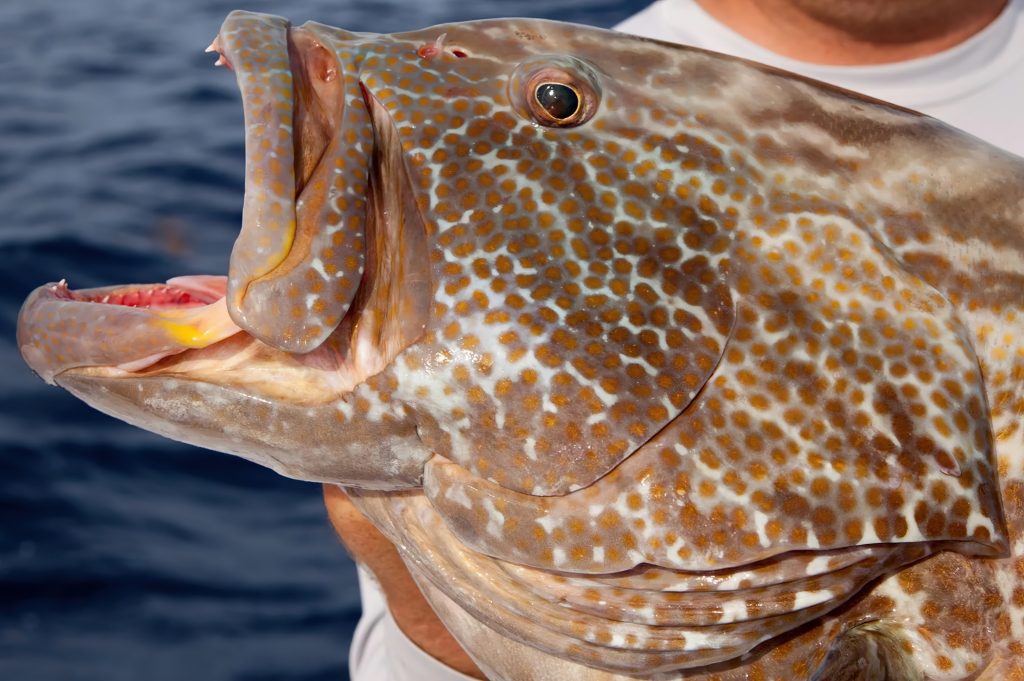- The Thrill of Grouper Fishing
- Understanding Grouper Behavior and Habitat
- Top Locations for Grouper Fishing
- Essential Gear for Successful Grouper Fishing
- Choosing the Right Bait and Lures for Grouper
- Effective Techniques for Catching Grouper
- Adapting to Different Grouper Fishing Conditions
- Tips for Locating Grouper
- Grouper Fishing Regulations and Conservation
- Embark on Your Grouper Fishing Adventure with Confidence
The Thrill of Grouper Fishing
Grouper fishing represents a challenge and a thrill for even the most seasoned anglers. These bottom-dwelling behemoths are known for their strength, size, and a remarkable ability to evade capture. This article aims to provide comprehensive insights into grouper fishing, focusing on their behavior, habitat, top fishing locations, and the best fishing techniques to reel in these elusive giants.
Understanding Grouper Behavior and Habitat
Groupers, as a species, are characterized by their love for the depths. They are primarily bottom dwellers, inhabiting the rocky seafloor, coral reefs, and underwater structures in tropical and subtropical waters. These habitats provide them with ample hiding spots, allowing them to ambush prey effectively. Groupers are opportunistic feeders, preying on a variety of sea creatures such as fish, octopuses, and crustaceans. Their powerful jaws allow them to crush and consume their meals with ease.
Top Locations for Grouper Fishing
The world is filled with numerous hotspots for grouper fishing. The Gulf of Mexico, especially off the coasts of Florida and Texas, boasts a healthy grouper population. The Bahamas, with their abundant coral reefs, also provide an excellent habitat for groupers. Globally, the Great Barrier Reef in Australia and the Gulf of Oman are popular destinations for grouper fishing enthusiasts.
Essential Gear for Successful Grouper Fishing
When it comes to grouper fishing, the right equipment is vital. Heavy-duty, high-capacity reels are a must, as groupers are known for their initial surge when hooked and their subsequent powerful runs. Rods need to be strong and resilient, capable of handling the fight a grouper puts up. Braided lines, known for their high strength-to-diameter ratio and resistance to abrasion, are an excellent choice. When it comes to terminal tackle, circle hooks are often preferred for their ability to hook the fish in the corner of the mouth, reducing the chance of the line being cut on the grouper’s sharp teeth or the rocky environment.
Choosing the Right Bait and Lures for Grouper
Choosing the right bait is critical for grouper fishing. Natural baits such as squid, sardines, and pinfish are highly effective. When it comes to artificial lures, large, deep-diving plugs, heavy jigs, and soft plastic lures rigged to a heavy jig head can yield great results.
Effective Techniques for Catching Grouper
There are various techniques that anglers employ to catch grouper. Bottom fishing is perhaps the most common method, given the grouper’s affinity for the seafloor. This technique involves dropping the bait down to the bottom and waiting for the grouper to bite. Trolling with large plugs is another effective method, especially over reefs and wrecks.
Adapting to Different Grouper Fishing Conditions
Successful grouper fishing requires an understanding of how various factors such as weather, time of day, and season can affect their behavior. Groupers tend to be more active and aggressive feeders on overcast days and during periods of low light, such as dawn and dusk. In terms of seasonal changes, the warmer months are generally more productive for grouper fishing, coinciding with their spawning season.
Tips for Locating Grouper
Groupers are structure-oriented fish, meaning they are often found around reefs, wrecks, ledges, and any other type of underwater structure that provides cover. When searching for these hotspots, a reliable depth finder can be an invaluable tool. Look for signs of irregularity on the seafloor or any large objects that could serve as a potential hiding spot for grouper.
Grouper Fishing Regulations and Conservation
Groupers, due to their size and the depth at which they are found, are subject to specific fishing regulations to ensure their populations remain sustainable. These regulations, which can vary by location and species, often stipulate size and bag limits. It’s crucial for all anglers to familiarize themselves with these regulations before heading out on a grouper fishing trip. Additionally, the practice of catch and release is encouraged, especially for juvenile and breeding adults.
Embark on Your Grouper Fishing Adventure with Confidence
Armed with the right knowledge, equipment, and respect for the species, any angler can undertake the challenge of grouper fishing. With their size, strength, and tenacity, groupers offer an angling experience like no other. Whether you’re a seasoned professional or a beginner, there’s always something new to learn in the art of grouper fishing. By continuously refining your skills and staying informed about the latest techniques and conservation efforts, you can contribute to the sport and ensure that future generations will also get to experience the thrill of catching these magnificent fish.
Remember, the joy of fishing doesn’t just come from the catch, but also from the thrill of the hunt and the beauty of the marine environment. So, gear up, stay patient, and enjoy the journey as you delve into the exciting world of grouper fishing.

